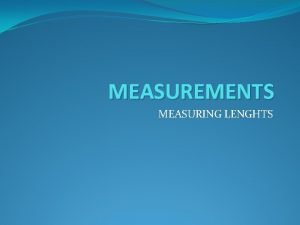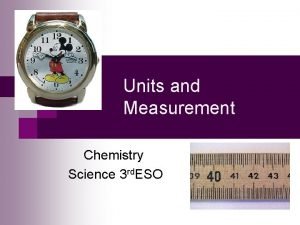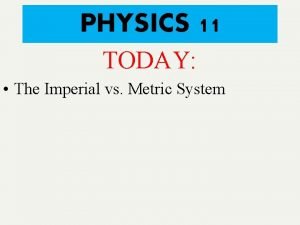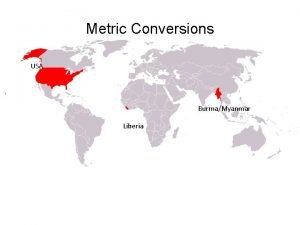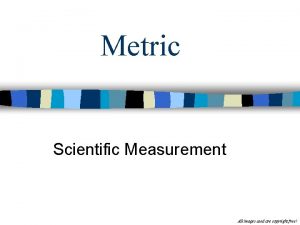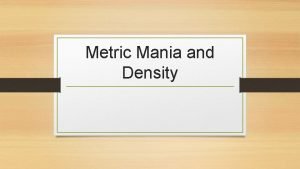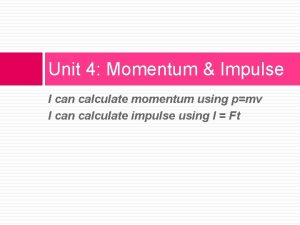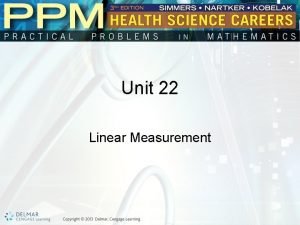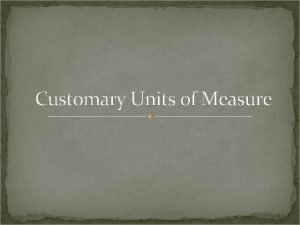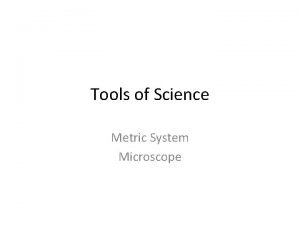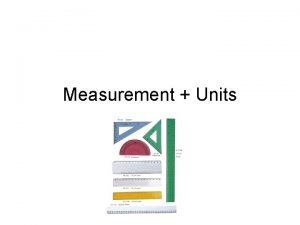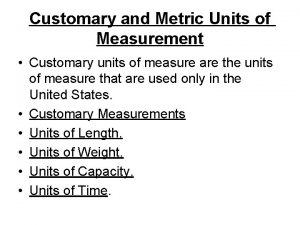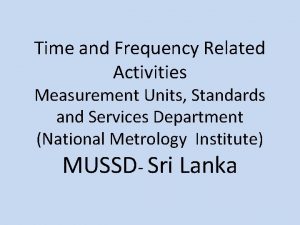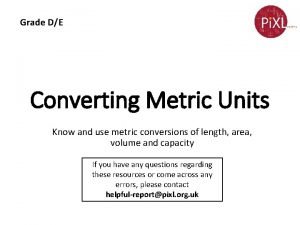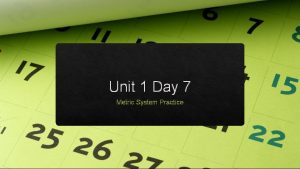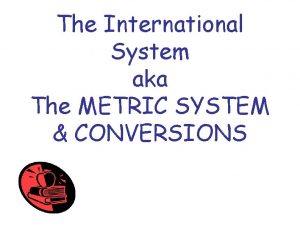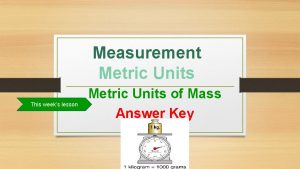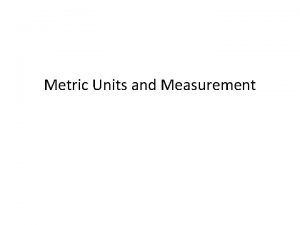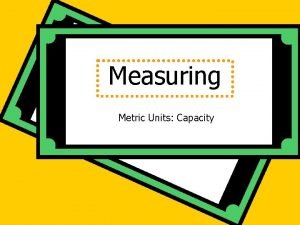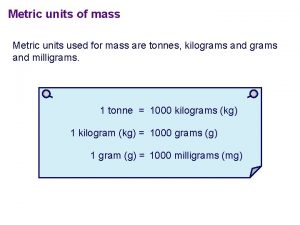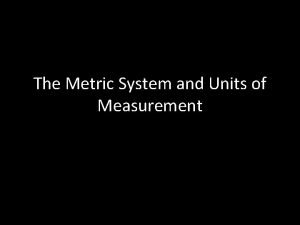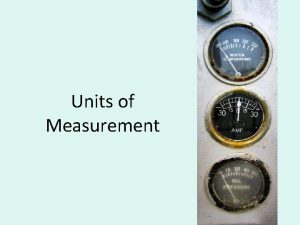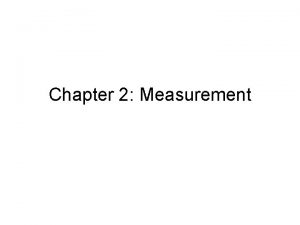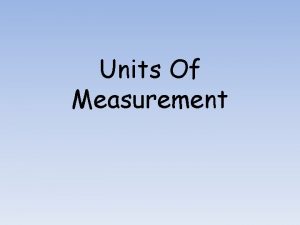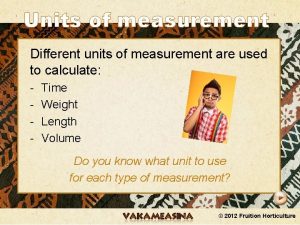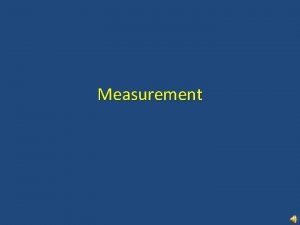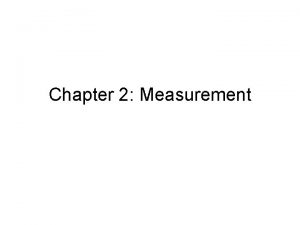PRESENTATION 8 Metric Measurement Units METRIC UNITS OF





















- Slides: 21

PRESENTATION 8 Metric Measurement Units

METRIC UNITS OF LINEAR MEASURE • Based on powers of 10 • Most frequently used units of length: • • kilometer centimeter millimeter

METRIC LINEAR UNITS • The following list shows several units of linear measure and their lengths in meters: 1 kilometer (km) = 1, 000 meters (m) 1 hectometer (hm) = 100 meters (m) 1 dekameter (dam) = 10 meters (m) 1 meter (m) = 1 meter (m) 1 decimeter (dm) = 0. 1 meter (m) 1 centimeter (cm) = 0. 01 meter (m) 1 millimeter (mm) = 0. 001 meter (m)

• CONVERTING METRIC LENGTHS Since the metric system is based on powers of 10, the easiest method of converting between metric units is by moving the decimal point • • To express a given unit as a larger unit, move the decimal point to left the number of places between the two units To express a given unit as a smaller unit, move the decimal point to right the number of places between the two units

• • CONVERTING METRIC LENGTHS Example: Express 65 decimeters as meters • Move the decimal 1 place to the left since a meter is the next larger unit to a decimeter 65 dm = 6. 5 m Example: Express 0. 28 decimeters as centimeters • Move the decimal 1 place to the right since a centimeter is the next smaller unit to a decimeter 0. 28 dm = 2. 8 cm

METRIC SURFACE AREA • As with linear measure, the easiest method of converting between metric units of surface area is by moving the decimal point • • To express a given unit as the next larger unit, move the decimal point two places to the left. Move two places because surface area is twodimensional To express a given unit as the next smaller unit, move the decimal point two places to the right

METRIC AREA CONVERSIONS • The table below reviews some common metric units, listing them from larger to smaller in order from left to right

METRIC AREA CONVERSIONS • Example: Express 840. 5 square decimeters (dm 2) as square meters (m 2) • • Since a square meter is the next largest unit to a square decimeter, move the decimal point 2 places to the left 840. 5 dm 2 = 8. 405 m 2 In moving the decimal point 2 places to the left, you are actually dividing by 100

METRIC AREA CONVERSIONS • Example: Express 46 square centimeters (cm 2) as square millimeters (mm 2) • • Since a square millimeter is the next smallest unit to a square centimeter, move the decimal point 2 places to the right 46 cm 2 = 4, 600 mm 2 In moving the decimal point 2 places to the right, you are actually multiplying by 100

METRIC VOLUME UNITS • As with linear and area measure, the easiest method of converting between metric units of volume is by moving the decimal point • For volume, the decimal will be moved three places because volume is threedimensional

METRIC VOLUME UNITS • Example: Express 27, 000 cubic centimeters (cm 3) as cubic meters (m 3) • • Since a cubic meter is 2 units larger than a cubic centimeter, the decimal point is moved 2 x 3 or 6 places to the left 27, 000 cm 3 = 0. 027 m 3 In moving the decimal point 6 places to the left, you are actually dividing by 1, 000 or 1, 000

• METRIC UNITS Commonly used capacity-cubic measure equivalents: 1 milliliter (m. L) = 1 cubic centimeter (cm 3) 1 liter (L) = 1 cubic decimeter (dm 3) 1 liter (L) = 1, 000 cubic centimeters (cm 3) • 1, 000 liters (L) = 1 cubic meter (m 3) Commonly used weight (mass) measure equivalents: 1, 000 milligrams (mg) = 1 gram (g) 1, 000 grams (g) = 1 kilogram (kg) 1, 000 kilograms (kg) = 1 metric ton (t)

COMPOUND UNITS • Products or quotients of two different units • • • Converted to smaller or larger equivalent compound unit measures, use the unity fractions Expressed using per, such as kilometers per hour, which indicates division Kilometers per hour can be written:

COMPOUND UNIT EQUIVALENTS • Simple compound needs only one unit to be converted • Complex compound needs more than one unit to be converted

COMPOUND UNIT EQUIVALENTS • Example: Express 62. 35 kilometers per hour as meters per minute • Multiply 62. 35 km/hr by the unity fractions = 1, 039. 1 ≈ 1, 039 m/min

METRIC-CUSTOMARY CONVERSIONS • • Length 1 in = 2. 54 cm 1 ft = 30. 48 cm 1 yd = 0. 9144 m 1 mi = 1. 6093 km Weight 1 oz = 28. 35 g 1 lb = 0. 4536 kg 1 (short) ton = 907. 2 kg • Volume 1 cu in (in 3) = 16. 387 cm 3 1 fl oz = 29. 574 cm 3 1 tsp = 4. 929 m. L 1 tbsp = 14. 787 m. L 1 qt = 0. 9464 L 1 gal = 3. 785 L

METRIC-CUSTOMARY CONVERSIONS • Example: Convert 7. 36 in to millimeters • This requires two unity fractions

METRIC-CUSTOMARY CONVERSIONS • Example: Convert 12. 75 ft 2 to square centimeters • This requires two unity fractions

PRACTICAL PROBLEMS • • • An assembly consists of 5 metal plates The respective plates are 650 cm 2, 800 cm 2, 16. 3 dm 2, 12 dm 2, and 0. 12 m 2 Determine the total surface measure, in square meters, of the 5 plates

PRACTICAL PROBLEMS • Convert each measure to square meters

PRACTICAL PROBLEMS • • Sum the measures 0. 0650 m 2 + 0. 080 m 2 + 0. 163 m 2 + 0. 12 m 2 = 0. 548 m 2 ≈ 0. 55 m 2 The sum of the measures of the 5 plates is about 0. 55 m 2
 Choosing appropriate metric units of measurement
Choosing appropriate metric units of measurement Meter centimeter table
Meter centimeter table Metric units of measurement
Metric units of measurement Metric units of measurement
Metric units of measurement Stair step metric conversion chart
Stair step metric conversion chart Metric measurement virtual lab
Metric measurement virtual lab Metric system of measurement
Metric system of measurement Googleclassroomn
Googleclassroomn Metric mania metric conversions
Metric mania metric conversions Mr. gallon
Mr. gallon Momentum measurement unit
Momentum measurement unit 3 units of linear measurements in metric system
3 units of linear measurements in metric system What is customary unit
What is customary unit Us customary units of measurement
Us customary units of measurement Units of measurement microscope
Units of measurement microscope Opisometer unit
Opisometer unit Chapter 1 physical quantities and measurement
Chapter 1 physical quantities and measurement Customary and metric units
Customary and metric units Mussd
Mussd Converting units of length
Converting units of length What are the 7 metric units?
What are the 7 metric units? Système impérial
Système impérial
